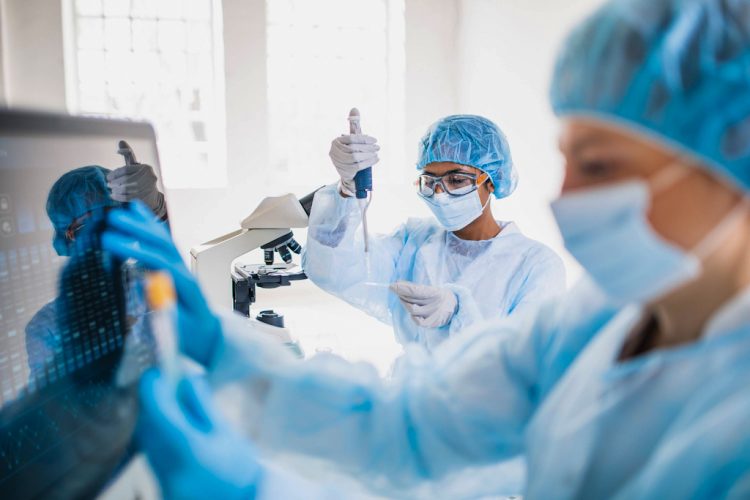A diagnostic kit for the detection of SARS-CoV-2 and new vaccine candidates more resistant to possible mutations of the coronavirus, are among the most recent contributions and results of Cuban science in the face of the pandemic, the official media reported.
In addition, a third prototype of a Cuban lung ventilator was also presented, “an initiative that seeks to avoid the collapse of intensive care services in the absence of these equipment,” according to Prensa Latina (PL) news agency.
The new diagnostic kit, which is used for the magnetic extraction of RNA from the virus with nanotechnology, was presented at the meeting that Cuban President Miguel Díaz-Canel systematically holds with scientists and experts from the island working on projects and research related to COVID -19.
“It is the laboratory reagent that allows the extraction of genetic material, which is an essential step in the process of determination of PCR tests,” explained at the meeting Dr. Angelina Díaz, director of the Center for Advanced Studies, quoted by Granma newspaper.
The specialist stated that the diagnostic kit was validated by the Pedro Kourí Institute of Tropical Medicine, has a 100% concordance with imported kits, does not require a cold chain and complies with the standards of the Cuban regulatory authority.
Dr. Díaz said that the aim is to produce kits for 20,000 daily samples, “from a production chain that involves several institutions, including a self-employed worker,” Granma noted, recalling that “so far, Cuba has managed to produce the swab for sampling, the means of transportation for their collection and transfer.”
For his part, Dr. Rolando Pérez, director of science and innovation of the BioCubaFarma business group, said that the idea is to assemble the complete system for the final diagnosis and that the created capacities would not only be for COVID-19, but for any disease of viral, bacterial and chronic non-communicable origin, including cancer.
“The project involves reaching the team that processes the PCR test, not just the person who does it. We are going to produce everything that is required for molecular diagnosis and we think that by 2022 we will have all that technology,” said Pérez at the meeting with Díaz-Canel, where, in addition, the results of studies on COVID-19 as a cause of death in 50 autopsies and on the aftereffects it leaves in several organs were presented. These studies contribute to a new treatment protocol for the disease that will be presented shortly.
Secuelas renales de la COVID-19 en la mira de la ciencia cubana
New vaccine projects and lung ventilators
This Wednesday it was also learned that Havana’s Center for Genetic Engineering and Biotechnology (CIGB), which already has in clinical trials the Mambisa and Abdala vaccines, is developing new vaccine candidates more resistant to possible SARS-CoV-2 mutations.
According to Dr. Gerardo Guillén, director of biomedical research at the CIGB, quoted by the Agencia Cubana de Noticias (ACN) news agency, “Cuban scientists are preparing to act in the face of variants of the disease that have a greater capacity to infect and aggravate damage to health.”
This is why, and although there is no evidence that current mutations affect the protective response of Cuban vaccine candidates, ongoing research “is incorporating new proteins to diversify the protective response” of the vaccines already under study.
Furthermore, Dr. Guillén confirmed that the preliminary results of Abdala and Mambisa, which use intramuscular and intranasal routes of administration, “demonstrate their suitability without presenting serious adverse effects.” Both products, which have already completed their first immunization, have the advantage that they are very safe, “as they are obtained from recombinant proteins through genetic engineering and do not use the live virus, which will allow more doses to be applied in the case of reducing immunity and also use them to reinforce other vaccines,” said the researcher.
COVID-19 vaccine clinical trial advances in Santiago de Cuba
Meanwhile, engineer Arlem Lesmes Fernández, general director of the Combiomed Digital Medical Technology Company, told Granma that his entity is working on the development of a third Cuban model of high-performance lung ventilator, “to be applied in ICUs in critical and seriously ill COVID-19 patients, or presenting other complications of various kinds.”
This high-end lung ventilator–which Fernández classified as “the most complex project” carried out by the company in more than 35 years of work–“will incorporate the standard ventilation modes worldwide, and will offer attractive and safe options of visualization, operation and connectivity,” according to the source, who adds that “all electronic, pneumatic, mechanical, industrial, graphic, firmware and software design solutions are the fruits of Cuban science.”
The forecasts point to the completion of the first prototypes in March, and their introduction into the Cuban health system in the second half of the year, “after the necessary and required tests to demonstrate their safety and efficacy, as part of the process for their Sanitary Registration in Cuba.” With this, “it must become an important source of import substitution, with a cost lower than half its price in the international market, in addition to representing a potential exportable item.”
Cuba currently has two models of its own lung ventilators: the Pcuvente and the Neuronic/Pcuvente v 1.0.
The first is an automatic device designed for emergency ventilation for short and uninterrupted periods. It allows the volumetric controlled and volume-assisted ventilation mode, and uses a battery, which makes it possible to work independently for more than one hour, and its use is focused on cases with mild respiratory distress, contributes to improving alveolar ventilation and, above all, it reduces the frequency of intubation, Prensa Latina reported.
The other model is the Neuronic/Pcuvente v 1.0 emergency lung ventilator, which has a mechanical and automatic compression of a self-inflating resuscitator, originally for manual use, and can be used in acute respiratory failure, where breathing is lacking or is very depressed or requiring its support for short periods.










